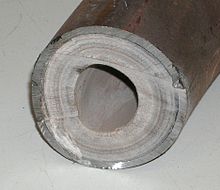Scale
Scale is a solid deposit on the walls of, for example, boilers (hence the name), pots or pipes that have been filled with water for a long time . Scale consists mostly of the alkaline earth salts calcium and magnesium carbonate , to a very small extent of silicates (see carbonate-silicate cycle ).
A particular type of scale is the pan stone , the predominantly food salt containing evaporation residue in salt works.
Emergence

In surface water that flows through calcareous soil, calcium and magnesium compounds dissolve through bound carbonic acid (carbon dioxide). The sum of the calcium and magnesium salts was previously known as the total hardness . By evaporation or heating of hard water , carbon dioxide escapes from it , the dissolved calcium hydrogen carbonate is converted into insoluble calcium carbonate (= lime) and precipitates occur, which are deposited on the walls of the vessel on already existing crystallization nuclei . By increasing the temperature, the formation of scale can be described by the following reaction:
For the geology and chemistry of the boiler stone , see Limestone , for a detailed explanation of its formation, see also Water hardness # lime-carbonic acid balance .
Distance and Avoidance
Scale is usually removed by boiling with dilute acids, for example citric acid or lactic acid . Furthermore, vinegar in particular is considered a home remedy for elimination. When decalcifying with vinegar, however, make sure that it attacks the rubber seals (e.g. in a coffee machine) and makes them porous. Especially in machines and pipelines in which scale has been deposited over years or decades, scale can usually only be removed mechanically by knocking off or blasting off. When using citric acid, care should be taken not to heat the water too much, as otherwise poorly soluble calcium citrate can precipitate (see also article citric acid ).
To prevent the formation of scale, the water can be softened before use .
A measure known as internal water treatment is based on the addition of phosphate to the boiler water. An excess causes the formation of calcium or magnesium phosphate, which settle as sludge on the bottom of the boiler and are removed from the boiler by sludge. A similar process is used for internal feed water treatment in steam locomotives .
In Italy it is customary to put a small chunk of marble in kettles to bind the lime to itself. The effectiveness of this method is controversial. The same applies to pieces of stainless steel mesh, which are also commercially available and are to be placed in the boiler as "lime catchers".
The dissolving of calcifications with the help of acetic acid happens according to the following reaction equation:
Scale deposits in steam boilers
In steam boilers that are operated with insufficiently treated boiler water, scale precipitates especially on heating surfaces . Scale containing gypsum has a thermal conductivity λ of 0.5 to 2.3 W / (m K) and scale rich in silicate from 0.08 to 0.18 W / (m K). Compared to steel (λ = 50 W / (m K)), the scale has a very low thermal conductivity and thus forms an insulating layer to the water space. This leads to an increase in temperature on the walls of the heating surfaces, with the result that the material expands more strongly on the overheated surfaces, and this can lead to cracks, especially at weld seams.
In water-tube boilers and high-speed steam generators, the water pipes can become so overgrown with scale deposits that the flow and thus cooling of the wall stop. Very thick scale deposits lead to a reduction in the yield strength of the material due to the high wall temperature. The affected components can, depending on the direction of the pressure load, dent or dent in the boiler and this can lead to the boiler failing ( boiler crack ).
The heat transfer in the boiler is reduced by the insulating effect of the boiler stone. The outlet temperature of the flue gas increases noticeably and thus the combustion efficiency, i.e. the temperature difference between the fireplace and the chimney, decreases.
In the 19th and 20th centuries, steam boilers were mostly operated without water treatment. The boiler scale therefore had to be mechanically knocked off by boiler knockers with pointed hammers . The specific heat load on the heating surfaces of the roller and flame tube boilers used at that time was relatively low and the boilers had no areas that were critical with regard to scale deposits, so that this mode of operation was possible. Modern steam boiler constructions with high combustion efficiencies (flame tube-smoke tube boiler) can be damaged by scale deposits after a short period of operation. For this reason, the treatment of the feed water with softening is absolutely necessary and stipulated in the regulations (e.g. TRD 611 ).
See also
literature
- Friedrich Barth: The steam boiler. Short textbook with examples for self-study and practical use. Volume 2: Construction and operation of the steam boiler (= Göschen Collection. Vol. 521). Göschen, Berlin 1911.
- Fritz Mayr (Ed.): Boiler operating technology. Power and heat generation in practice and theory. 10th edition. Publishing house Dr. Ingo Resch, Graefelfing 2003, ISBN 3-930039-13-3 .
- Karl J. Spurzem: The secret of the Schietgangs. In: Mare. The magazine of the seas . No. 66, February / March 2008, p. 80.
- Association of German Engineers, VDI Society for Process Technology and Chemical Engineering (publisher): VDI-Wärmeatlas. Calculation sheets for heat transfer. 3rd, revised edition. VDI-Verlag, Düsseldorf 1977, ISBN 3-18-400373-6 .
Individual evidence
- ↑ Prof. Blum's media offer: Chemistry for elementary school and chemistry entry-level lessons: Why you shouldn't descale coffee machines with citric acid .
- ↑ Otto-Albrecht Neumüller (Ed.): Römpps Chemie-Lexikon. Volume 3: H-L. 8th revised and expanded edition. Franckh'sche Verlagshandlung, Stuttgart 1983, ISBN 3-440-04513-7 , pp. 1596-1600.




